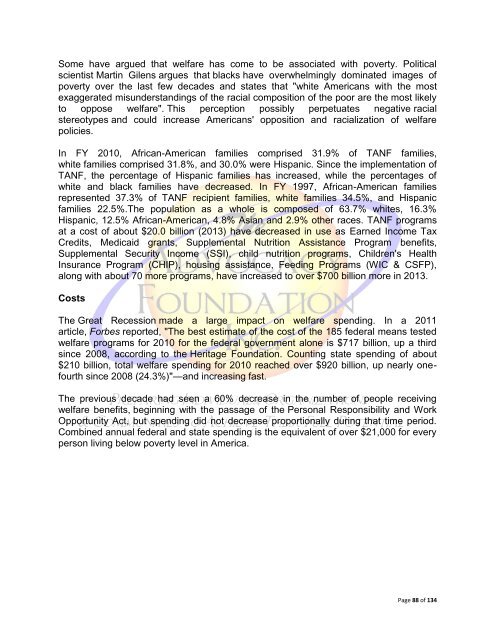Concentrated Poverty
Concentrated Poverty
Concentrated Poverty
Create successful ePaper yourself
Turn your PDF publications into a flip-book with our unique Google optimized e-Paper software.
Some have argued that welfare has come to be associated with poverty. Political<br />
scientist Martin Gilens argues that blacks have overwhelmingly dominated images of<br />
poverty over the last few decades and states that "white Americans with the most<br />
exaggerated misunderstandings of the racial composition of the poor are the most likely<br />
to oppose welfare". This perception possibly perpetuates negative racial<br />
stereotypes and could increase Americans' opposition and racialization of welfare<br />
policies.<br />
In FY 2010, African-American families comprised 31.9% of TANF families,<br />
white families comprised 31.8%, and 30.0% were Hispanic. Since the implementation of<br />
TANF, the percentage of Hispanic families has increased, while the percentages of<br />
white and black families have decreased. In FY 1997, African-American families<br />
represented 37.3% of TANF recipient families, white families 34.5%, and Hispanic<br />
families 22.5%.The population as a whole is composed of 63.7% whites, 16.3%<br />
Hispanic, 12.5% African-American, 4.8% Asian and 2.9% other races. TANF programs<br />
at a cost of about $20.0 billion (2013) have decreased in use as Earned Income Tax<br />
Credits, Medicaid grants, Supplemental Nutrition Assistance Program benefits,<br />
Supplemental Security Income (SSI), child nutrition programs, Children's Health<br />
Insurance Program (CHIP), housing assistance, Feeding Programs (WIC & CSFP),<br />
along with about 70 more programs, have increased to over $700 billion more in 2013.<br />
Costs<br />
The Great Recession made a large impact on welfare spending. In a 2011<br />
article, Forbes reported, "The best estimate of the cost of the 185 federal means tested<br />
welfare programs for 2010 for the federal government alone is $717 billion, up a third<br />
since 2008, according to the Heritage Foundation. Counting state spending of about<br />
$210 billion, total welfare spending for 2010 reached over $920 billion, up nearly onefourth<br />
since 2008 (24.3%)"—and increasing fast.<br />
The previous decade had seen a 60% decrease in the number of people receiving<br />
welfare benefits, beginning with the passage of the Personal Responsibility and Work<br />
Opportunity Act, but spending did not decrease proportionally during that time period.<br />
Combined annual federal and state spending is the equivalent of over $21,000 for every<br />
person living below poverty level in America.<br />
Page 88 of 134

















